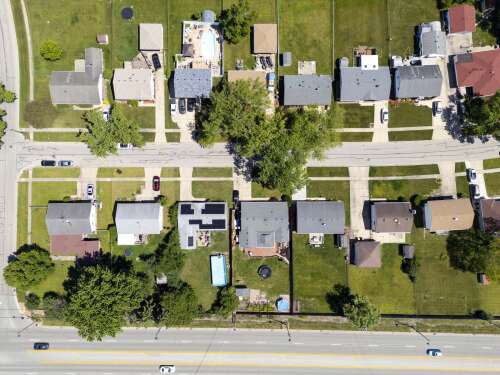Whatever a community’s leading issue is, there’s a tree for it.
Whether it’s saving money, reducing crime or improving water quality, “there’s a tree for a lot of things that people care about,” says Michael Dugan, director of forestry for conservation nonprofit Openlands. “(Trees) can be a force multiplier for really making a healthier community for people to live in, whether they’re urban or suburban.”
Awareness of trees for more than aesthetic benefit has grown in recent years, with communities and environmental organizations putting more trees in the ground and more emphasis on caring for the Chicago area’s existing canopy.
But trees and their benefits are not distributed evenly, typically following racial and economic lines. And while disparities in tree cover are more well-known in Chicago proper, one recent study found tree inequality actually is worse suburb to suburb. That’s because there’s more space for it.
In highly dense urban areas like Chicago, there’s a distinct difference in canopy density between high- and low-income neighborhoods, but that difference often is only a few percentage points.
“When you get out to the suburbs, you do have huge differences,” said Robert McDonald, a lead scientist at The Nature Conservancy and co-author of the study. “You have a lot of variance. You might have an average tree cover in a rich suburb that’s 50%, and then in a poor suburb you might have 10% so … the difference is quite big. But it’s just because there’s more space, so there’s more potential.”
To address gaps in Chicago’s suburban tree canopy, they first have to be identified.
The Morton Arboretum’s Chicago Region Trees Initiative has completed extensive mapping of the seven-county area using data from its 2010 and 2020 tree censuses, the result being localized canopy data for each county and municipality. (The program also has data for each of Chicago’s wards and neighborhoods.)
For instance, data shows Arlington Heights has 28% canopy cover, while Elk Grove Village has 17%. For comparison, the Chicago region as a whole has 23% — far below the national average of nearly 40%.
The initiative also maps the region by issues associated with low tree cover, such as surface temperature, flood risk and air pollutants. By cross-checking where trees aren’t and where challenges are, advocates can prioritize their efforts.
“It’s important to look at not only tree canopy, but some of the things that increasing that canopy can help offset — things like urban heat,” said Zach Wirtz, director of the Chicago Region Trees Initiative. “Trees can have a great impact on reducing heat in urban areas, and so areas that have existing high surface temperatures and low canopy are a great place for us to kind of focus efforts.”
As awareness of trees and their benefits have grown, so has funding. Most recently, the arboretum began distributing $6.9 million in grants to help priority communities plant and care for trees.
Provided through the 2022 Inflation Reduction Act, the grants are part of an unprecedented $1.5 billion federal investment to boost urban tree cover nationwide.
Recent suburban grantees include Elgin, Streamwood, Franklin Park and Burbank. Funding is targeted to reach government entities that meet federal requirements as “disadvantaged.”
In Streamwood, the village will plant 119 trees in various disadvantaged areas, replacing trees previously cut down due to disease or other impacts.
Meanwhile, Elgin plans to plant 100 oak trees next spring in Lords Park, located on the east side of the city and within walking distance from many homes in disadvantaged areas. While the park has been known over the years for having a large grove of oak trees, the green space has lost several old oaks to issues like oak wilt.
The projects bring into light not only the cost of planting new trees but the challenges of caring for existing ones. For Dugan of Openlands, urban forestry is a three-part process: planting, maintaining and protecting.
Openlands tackles those three parts through a slew of solutions, including community education and engagement, workforce development, and policy work. On the equity side, that means working with municipalities that see a need for increasing tree capacity, but don’t necessarily have the staff, experience or resources to do so.
“If we’re talking about tree canopy, a large tree is exponentially more impactful than planting many small ones,” he said. “It’s a story that we encounter all the time: People don’t know how important or impactful that tree in front of their home was until it was gone.”
Bellwood, a suburban community that recently has worked with Openlands, planted dozens of trees along its section of the Illinois Prairie Path this year. The village also received funding from ComEd and the Metropolitan Water Reclamation District to plant 200 more.
With a history of severe flooding, the village hopes to build an urban forest that will help absorb rainwater and slow runoff using the Miyawaki method. The strategy, which replicates native forest ecosystems, looks to densify green cover within a small parcel of land.
Tonita LeShore, Bellwood’s director of human resources, added the village’s efforts are distinctly in line with climate resilience goals.
“If we want to leave this world a better place for our children, our grandchildren, our great grandchildren, then we have to act now in order for that to happen,” she said.
• Jenny Whidden, jwhidden@dailyherald.com, is a climate change and environment writer working with the Daily Herald through a partnership with Report For America supported by The Nature Conservancy. Help support her work with a tax-deductible donation at dailyherald.com/rfa.
An aerial view looking east along Irving Park Road across from Kollar Park shows the tree canopy in Streamwood.
Brian Hill/bhill@dailyherald.com
An aerial view looking west from Eagles Burnidge Park shows the tree canopy in Elgin. Eagles Burnidge Park is a 56-acre parcel of scenic prairie and mature woods, located along Tyler Creek on the old Eagle’s Club property.
Brian Hill/bhill@dailyherald.com
